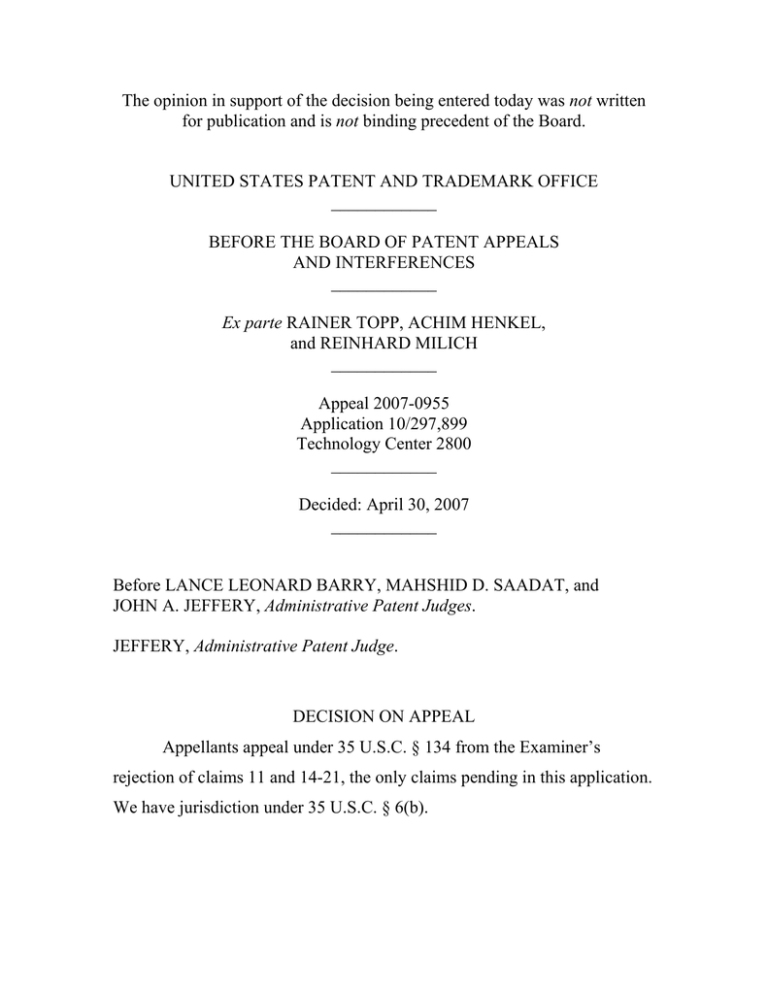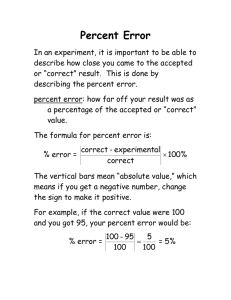The opinion in support of the decision being entered today was not
advertisement

The opinion in support of the decision being entered today was not written for publication and is not binding precedent of the Board. UNITED STATES PATENT AND TRADEMARK OFFICE ____________ BEFORE THE BOARD OF PATENT APPEALS AND INTERFERENCES ____________ Ex parte RAINER TOPP, ACHIM HENKEL, and REINHARD MILICH ____________ Appeal 2007-0955 Application 10/297,899 Technology Center 2800 ____________ Decided: April 30, 2007 ____________ Before LANCE LEONARD BARRY, MAHSHID D. SAADAT, and JOHN A. JEFFERY, Administrative Patent Judges. JEFFERY, Administrative Patent Judge. DECISION ON APPEAL Appellants appeal under 35 U.S.C. § 134 from the Examiner’s rejection of claims 11 and 14-21, the only claims pending in this application. We have jurisdiction under 35 U.S.C. § 6(b). Appeal 2007-0955 Application 10/297,899 STATEMENT OF THE CASE Appellants invented a plug connector with two superimposed connecting parts: a first connecting part only for the input terminals, and a second connecting part only for the output terminals. In one embodiment, the first connecting part includes a separate terminal connector strip for each input terminal. The strip includes at least as many connecting points as there are possible associated output terminals. Each output connection is connected to the associated input connection via a connecting point on the corresponding terminal connector strip. Such a construction, among other things, reduces complexity of the connecting parts themselves thus reducing manufacturing costs. 1 Claim 11 is illustrative: 11. A plug connector for a control device, comprising: a plug input having at least two input connections; a plug output having at least two output connections; and at least one connecting part for interconnecting the at least two input connections and the at least two output connections, the at least one connecting part including a first connecting part and a second connecting part for decoupling the plug input from the plug output, the first connecting part including the at least two input connections and the second connecting part including the at least two output connections, the first connecting part and the second connecting part being arranged on top of one another so that respective associated connections are connected to each other at an intersection point by a contact region, wherein the first connecting part includes a separate terminal connector strip for each of the at least two input connections, which provides at least as many connecting points as there are possible associated output connections, so that each of the at least two output connections is connected to an associated input connection via a connecting 1 See generally Specification page 2, line 3 – page 3, line 19. 2 Appeal 2007-0955 Application 10/297,899 point on a respective terminal connector strip, and wherein each of the at least two output connections on the second connecting part is conducted only to the respective terminal connector strip of the associated input connection. The Examiner relies on the following prior art reference to show unpatentability: Oka US 6,635,824 B1 Oct. 21, 2003 (filed Jul. 20, 2000) The Examiner’s rejection is as follows: Claims 11 and 14-21 are rejected under 35 U.S.C. § 102(e) as being anticipated by Oka or, in the alternative, under U.S.C. § 103(a) as obvious over Oka. 2 Rather than repeat the arguments of Appellants or the Examiner, we refer to the Brief and the Answer for their respective details. In this decision, we have considered only those arguments actually made by Appellants. Arguments which Appellants could have made but chose not to make in the Brief have not been considered and are deemed to be waived. See 37 C.F.R. § 41.37(c)(1)(vii). The Examiner has indicated how the claimed invention is deemed to be fully met by or rendered obvious over the disclosure of Oka (Answer 34). Regarding independent claim 11, Appellants argue that Oka does not disclose or suggest the following limitations: (1) decoupling the plug input 2 The Examiner withdrew rejections based on other prior art references, specifically Onizuka and Kasai (Answer 3). Accordingly, those references are not before us. 3 Appeal 2007-0955 Application 10/297,899 and the plug output; (2) the first connecting part including a separate terminal connector strip for each of the at least two input connections; and (3) connecting each of the at least two output connections to an associated input connection via a connecting point on a respective terminal connector strip, and each of the at least two output connections on the second connecting part is conducted only to the respective terminal connector strip of the associated input connection (Br. 7). In this regard, Appellants contend that although points of conduction amongst perpendicular bus bars may be selected for a desired application in Oka, the reference nevertheless does not teach nor suggest that the interconnected bus bars are isolated into input and output connections respectively. Appellants note that selectively joining the perpendicular bus bars in Oka is merely to create a connection structure and does not teach or suggest isolating or decoupling the input connections from the output connections as claimed (Br. 8). The Examiner responds that the device shown in Figs. 3B and 5A would include an input and an output. The Examiner adds that Oka’s device is essentially the same as the claimed invention that involves stacked conductive strips that are conductively joined at crossover points with connection regions at their ends (Answer 4-5). For the reasons that follow, we affirm. ISSUE Have Appellants established that the Examiner erred in finding that the junction connector structure of Oka anticipates the claims? 4 Appeal 2007-0955 Application 10/297,899 FINDINGS OF FACT Oka discloses a junction connector with junction circuits including multiple bus bar layers 14 and 16 separated by an insulating sheet 17. In one embodiment, multiple bus bars 13 and 15 in the first and second bus bar layers 14 and 16 are fitted into corresponding grooves 17a disposed on opposite sides of the insulating sheet. End tabs 13a, 13b, 15a, and 15b are provided on opposite ends of the bus bars 13 and 15. Selected bus bars 13 and 15 are connected together at cross positions P1-P6 through openings 17b in the insulating sheet. To this end, bus bars 13 are bent such that they contact bus bars 15. See Fig. 7. Both bus bars are then joined by resistance welding or, alternatively, by fasteners (Oka, col. 3, l. 64 – col. 4, l. 35; col. 5, ll. 64-67; Figs. 5A-7 and 13). PRINCIPLES OF LAW Anticipation is established only when a single prior art reference discloses, expressly or under the principles of inherency, each and every element of a claimed invention as well as disclosing structure which is capable of performing the recited functional limitations. RCA Corp. v. Applied Digital Data Systems, Inc., 730 F.2d 1440, 1444, 221 USPQ 385, 388 (Fed. Cir. 1984); W.L. Gore and Associates, Inc. v. Garlock, Inc., 721 F.2d 1540, 1554, 220 USPQ 303, 313 (Fed. Cir. 1983). ANALYSIS We agree with the Examiner that Oka fully meets all limitations of independent claim 11. First, the scope and breadth of the claim language simply does not preclude the end tabs 13a of the first bus bars 13 as 5 Appeal 2007-0955 Application 10/297,899 reasonably comprising the “plug input” giving the term its broadest reasonable interpretation. Likewise, the end tabs 15a of the second bus bars 15 reasonably comprise the “plug output.” Also, the claimed “connecting part” is fully met by the two perpendicular arrays of bus bars 16 and 14 with insulating sheet 17 therebetween. That is, the “first connecting part” is fully met by the array of upper bus bars 14 (i.e., “terminal connector strips”) and the associated face of insulating sheet 17 whose grooves 17a accommodate the upper bus bars. Likewise, the “second connecting part” is fully met by the array of lower bus bars 16 (i.e., “terminal connector strips”) and the associated face of insulating sheet 17 whose grooves 17a accommodate the lower bus bars. Selected bus bars within the array are connected together at “connecting points” P1-P6 (Oka, col. 4, ll. 10-25; Figs. 5A-7). As shown in Fig. 5B of Oka, two of the lower bus bar terminal strips 15 are each connected solely to corresponding upper bus bar terminal strips 13 at connecting points P3 and P4 respectively. In our view, this particular connection fully meets the limitation calling for at least two output connections to be connected to an associated input connection via a connecting point on a respective terminal strip as claimed. Moreover, this connection fully meets the limitation calling for each of the at least two output connections on the second connecting part to be conducted only to the respective terminal connector strip of the associated input connection as claimed. Lastly, we note that Oka’s second connecting part noted above is capable of “decoupling the plug input from the plug output” as claimed giving the term “decoupling” its broadest reasonable interpretation. 6 Appeal 2007-0955 Application 10/297,899 Significantly, we note that such decoupling could be achieved in Oka merely by not connecting two upper and two lower terminal strips together. Decoupling could also be achieved by merely disconnecting selected welded or fastened bus bar connections at the connecting points. See Oka, col. 4, ll. 24-26 (noting that bus bars can be removed for unused portions in the circuitry); see also Oka, col. 5, ll. 64-67 and Fig. 13 (noting that the upper and lower bus bars can be joined by fasteners in lieu of welding). In short, we see no reason why Oka’s second connecting part would not be at least capable of “decoupling the plug input from the plug output” as claimed. The limitation is therefore fully met by Oka. For at least these reasons, we find claim 11 anticipated by Oka. Accordingly, we need not reach the Examiner’s alternative obviousness rejection of this claim. Moreover, since Appellants have not separately argued the patentability of dependent claims 14-21, these claims fall with independent claim 11. See In re Nielson, 816 F.2d 1567, 1572, 2 USPQ2d 1525, 1528 (Fed. Cir. 1987); see also 37 C.F.R. § 41.37(c)(1)(vii). CONCLUSION OF LAW On the record before us, Appellants have not established that the Examiner erred in finding that the junction connector structure of Oka anticipates the claims. DECISION We have sustained the Examiner's anticipation rejection with respect to all claims on appeal. Therefore, the Examiner’s decision rejecting claims 11 and 14-21 is affirmed. 7 Appeal 2007-0955 Application 10/297,899 No time period for taking any subsequent action in connection with this appeal may be extended under 37 C.F.R. § 1.136(a)(1)(iv). AFFIRMED tdl/gw KENYON & KENYON LLP ONE BROADWAY NEW YORK, NY 10004 8

